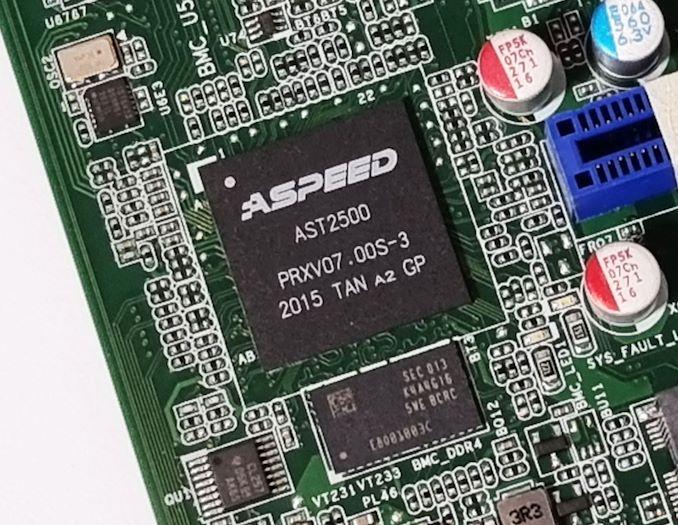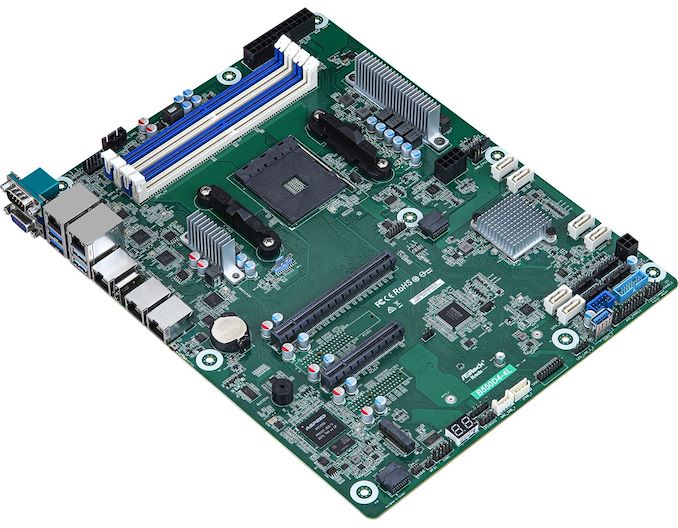ASRock Rack B550D4-4L Motherboard Review: B550 Goes Professional with BMC
by Gavin Bonshor on May 20, 2021 9:00 AM ESTConclusion
Not every motherboard is created equally, nor is every motherboard created with the same functionality as other models. Typically as seen on Intel platforms, it has its consumer-level chipsets such as B560, Z590, Z490, etc, but it also has a level pegged W480 chipset for professional users, which falls outside of its typical industrial level Xeon Scalable platform. Looking at AMD, it doesn't really do this with its desktop platforms, and users looking for workstation-level performance with consumer-level functionality can opt for Threadripper. The other options include Ryzen for desktop, and EPYC for enterprise, cloud, and server, with no real in-between.
When we first got wind of the ASRock Rack B550D4-4L back in January, it piqued our interest as it's the only known board to us that uses AMD's B550 desktop chipset to feature a BMC controller, in this case, an ASPEED AST2500, which is commonly used on professional level boards such as this. Another unique feature of the B550D4-4L is that it has four Intel Gigabit Ethernet ports on the rear, with a fifth designed to provide users access to the board's IPMI, for remote access purposes.
Being on an AMD Ryzen desktop platform, this allows users to use PCIe 4.0, with one full-length PCIe 4.0 x16 slot, and one half-length PCIe 4.0 x4 slot. Typically B550 boards only have one PCIe 4.0 slot, and this is where the B550D4-4L opts for a second PCIe 4.0 slot over a Gen 4 M.2 slot. Instead, the board has one PCIe 3.0 x4 M.2 slot, which supports SATA. As we know, the B550 chipset itself uses PCIe 3.0 lanes, and ASRock Rack is routing this through AMD's modular chipset and tracing to add the second PCIe 4.0 x4 half-length slot. Other storage options include six SATA ports, with four from the chipset with RAID 0, 1, and 10 support, and two via an ASMedia ASM1061 SATA controller.
Functionality and usability are two key parameters to look for in a server-focused model, and the B550D4-4L provides plenty of this, with an intuitive and accessible IMPI interface. We've highlighted that the ASRock Rack IPMI is functional in previous reviews, and the B550D4-4L is no different in this regard. There is also plenty of functionality within the firmware, with B550 specific options including access to AMD Ryzen's Precision Boost Overdrive settings, as well as an LN2 mode, which seems completely out of tune with the board's core values. We really wouldn't recommend overclocking a Ryzen 3000 or 5000 series desktop processor on this board, primarily due to the design of the 4+2 power delivery, and the inadequate heatsinks designed to cool it.

The ASPEED AST2500 BMC chip on the ASRock Rack B550D4-4L motherboard
Focusing on the performance, and the B550D4-4L was surprisingly competitive when compared to other B550 models, not just in our system testing, but in our computational benchmarks too. It has Precision Boot Overdrive (PBO) applied by default, which allowed our Ryzen 7 3700X processor to stretch its legs a little, especially when cooled with our Corsair H150i Elite Capellix 360 mm AIO cooler. The only negative in performance came in our DPC latency testing, with our results showing that this board isn't suitable for DAW systems. In the firmware, we did try setting the same settings as other B550 models on test, but no matter what we inputted in relation to memory settings, the latencies wouldn't change on our memory and resulted in DDR4-3200 with CL22 latencies; this would have a negative impact on general compute performance, but with DDR4-3200 CL16, we would expect it to be highly competitive with other models we've tested.
Final Thoughts
The ASRock Rack B550D4-4L at the time of writing is in a league of its own, with no other AMD B550 series motherboards offering a BMC controller. Another factor to consider here is we haven't been able to find this model anywhere at retail, and we don't have any official MSRP pricing at this time. This makes it tricky, to sum up as it's hard to recommend a model we can't physically get our hands on globally. We do expect the B550D4-4L to be available at retail at some point, and when it eventually is, it offers an interesting professional-level take on AMD's consumer B550 platform.
It keeps up with other B550 in terms of performance which is surprising, but it also has an excellent IPMI interface for easy access and usability. This makes the B550D4-4L one of the most interesting B550 models we've seen so far, especially with four Gigabit Ethernet ports.











73 Comments
View All Comments
mode_13h - Saturday, May 22, 2021 - link
Yeah, but 5x 1 gigabit ports is kinda ridiculous. It's not as if that costs nothing and uses no PCIe lanes.Spunjji - Monday, May 24, 2021 - link
It costs very little and uses very few lanes, though - depending on how they've done it, it could be as few as one lane for the 4 1GbE ports but is likely no more than 2. The management port will be using another, but that's still plenty left over for whatever the user needs.Spunjji - Monday, May 24, 2021 - link
"The exact smae argument could be made the other way around"Only if you ignore cost! It makes sense to integrate the minimum where upgrades are possible, rather than forcing the far higher cost of 10GbE everyone who buys your board.
fmyhr - Thursday, May 20, 2021 - link
Yup! Love that they put GOOD 1Gb NICs in there: i210s. Perfect for edge router, physically isolating different networks.Lucky Stripes 99 - Thursday, May 20, 2021 - link
I also agree that dual 2.5 Gbps would be more ideal as the market begins to move away from 1 Gbps. There are niche uses for quad Eth port boards, but the ones I'm most familiar with tend to use smaller form-factor boards.I get the feeling that this was designed for a specific industrial/embedded customer with a unique use case who didn't mind Asrock releasing to the general market.
BedfordTim - Friday, May 21, 2021 - link
You could for example hook up 4 GiGE cameras. Most can't take advantage of 2.5Gbe ports, but saturate a 1Gbe port.BedfordTim - Friday, May 21, 2021 - link
There are quite a few Atom boards with 2.5Gbe ports now.ZENSolutionsLLC - Friday, May 21, 2021 - link
Because regardless of the bandwidth, a single 10G nic is a single point of failure, which is a big NO NO in a corporate Enterprise IT environment. Multi 1GB nics are used (still very much) for LACP links spanning multiple switching fabrics. Also highly used on VMWare and HyperV hosts to separate out management traffic, VMotion, etc... and for aggregation and link failover.Jorgp2 - Friday, May 21, 2021 - link
The fuck kind of server would have 2.5G or 5G ethernet?bananaforscale - Saturday, May 22, 2021 - link
A roll your own NAS.